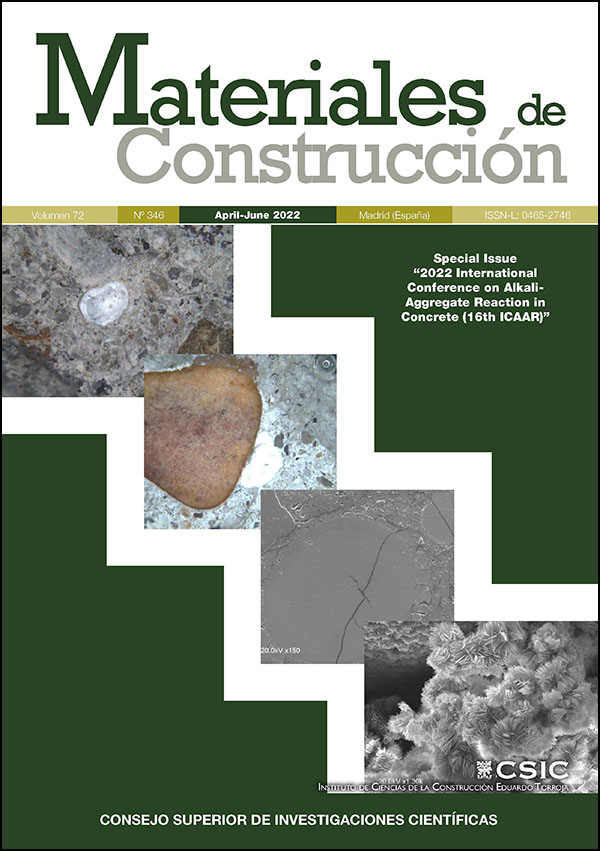Long-term efficiency of silica fume and fly ash to suppress ASR in field structures
DOI:
https://doi.org/10.3989/mc.2022.15821Keywords:
Alkali-aggregate reaction, Concrete prism test, Field exposure, Validation, MicrostructureAbstract
The potential of ASR in concrete can be assessed by the concrete prism test. However, the transferability of the results obtained with accelerated tests to concrete behavior under field conditions has to be validated. Such a validation was performed ten years ago for concrete produced with Portland cement and various Swiss aggregates. In recent years, the use of supplementary cementitious materials (SCM) has increased. So far, no validation for such types of concrete has been conducted in Switzerland. The goal of the current project is to fill this gap and provide the missing validation. Eight structures where chosen for the investigation. In all of them concrete containing SCM was used and the results of the concrete prism test at time of construction were available. In general, the results of the concrete prism test correlate with the degree of damage in the structures assessed by the analysis of the microstructure.
Downloads
References
Leemann, A.; Merz, C. (2013) An attempt to validate the ultra-accelerated microbar and the concrete performance test with the degree of AAR-induced damage observed in concrete structures. Cem. Concr. Res. 49, 29-37. https://doi.org/10.1016/j.cemconres.2013.03.014
Thomas, M.; Fournier, B.; Folliard, K.J.; Ideker, J.; Shehata, M. (2006) Test methods for evaluating preventive measures for controlling expansion due to alkali-silica reaction in concrete. Cem. Concr. Res. 36 [10], 1842-1856. https://doi.org/10.1016/j.cemconres.2006.01.014
Fournier, B.; Ideker, J.H.; Folliard, K.J.; Thomas, M.D.A.; Nkinamubanzi, P-C.; Chevrier, R. (2009) Effect of environmental conditions on expansion in concrete due to alkali-silica reaction (ASR). Mater. Charact. 60 [7], 669-679. https://doi.org/10.1016/j.matchar.2008.12.018
Ideker, J.H.; Drimalas, T.; Bentivegna, A.F.; Folliard, K.J.; Fournier, B.; Thomas, M.D.A.; Hooton, R.D.; Rogers, C.A. (2012) The importance of outdoor exposure site testing. In: Proceedings of the 14th International Conference on Alkali Aggregate Reactions (ICAAR), Austin, Texas.
Fournier, B.; Chevrier, R.; Bilodeau, A.; Nkinamubanzi, P.C.; Bouzoubaa, N. (2016) Comparative field and laboratory investigations on the use of supplementary cementing materials (SCMs) to control alkali-silica reaction (ASR) in concrete. In: Proceedings of the 15th International Conference on Alkali Aggregate Reactions (ICAAR), Sao Paolo, Brasil.
Wigum, B.J.; Einarsson, G.J. (2016) Alkali aggregate reaction in Iceland: results from laboratory testing compared to field exposure site. In: Proceedings of the 15th International Conference on Alkali Aggregate Reactions (ICAAR), Sao Paolo, Brasil.
Merz, C.; Leemann, A. (2019) AAR-Prävention für Beton: Erfahrungen mit Zusatzstoffen, Bericht VSS Nr. 694, Bern.
AFNOR XP 18-594 (2004) Méthodes d'essai de reactivité aux alcalis. Association Française de Normalisation, Paris.
SN 505 262/1 (2019) Betonbau - Ergänzende Festlegungen. Appendix G. Schweizer Ingenieur- und Architektenverein, Zürich.
Leemann, A.; Griffa, M. (2013) Diagnosis of alkali- aggregate reaction in dams, state of the art report, SFOE-Project SI/500863-01, Bern.
Thaulow, N.; Jakobsen, U.H.; Clark, B. (1996) Composition of alkali silica gel and ettringite in concrete railroad ties: SEM-EDX and X-ray diffraction analyses. Cem. Concr. Res. 26 [2], 309-318. https://doi.org/10.1016/0008-8846(95)00219-7
Katayama, T.; Drimalas T.; Ideker J.H.; Fournier B. (2012) ASR gels and their crystalline phases in concrete - universal products in alkali-silica, alkali-silicate and alkali-carbonate reactions. In Proceedings of the 14th International Conference on Alkali Aggregate Reactions (ICAAR), Austin, Texas (pp. 20-25).
Leemann, A.; Shi, Z.; Wyrzykowski, M.; Winnefeld, F. (2020) Moisture stability of crystalline alkali-silica reaction products formed in concrete exposed to natural environment. Mater. Design. 195, 109066. https://doi.org/10.1016/j.matdes.2020.109066
Published
How to Cite
Issue
Section
License
Copyright (c) 2022 Consejo Superior de Investigaciones Científicas (CSIC)

This work is licensed under a Creative Commons Attribution 4.0 International License.
© CSIC. Manuscripts published in both the printed and online versions of this Journal are the property of Consejo Superior de Investigaciones Científicas, and quoting this source is a requirement for any partial or full reproduction.All contents of this electronic edition, except where otherwise noted, are distributed under a “Creative Commons Attribution 4.0 International” (CC BY 4.0) License. You may read here the basic information and the legal text of the license. The indication of the CC BY 4.0 License must be expressly stated in this way when necessary.
Self-archiving in repositories, personal webpages or similar, of any version other than the published by the Editor, is not allowed.


















